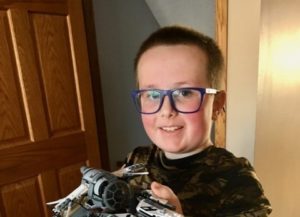Tom
Share This Post
Tom was almost three years old when it all started. Before, he was inconsolable and cried a lot. As a baby, he wanted to be carried constantly and only felt comfortable when he was held. However, the paediatrician’s examinations found nothing specifically wrong.
We were on our way to the zoo on a typical Saturday when he had his first grand mal seizure in the car. This required emergency medical intervention and a transport to the hospital. The same day he had two more Grand Mal Seizures. After a few days we were discharged and instructed to observe watch for any recurrent seizures. In the following days, Tom had several hundred tonic seizures. Mostly they occurred on the right side only, but sometimes on both sides.
Then came three more years with all forms of seizures such as tonic, atonic, myoclonic astatic, myoclonic and absences seizures. The atonic and the Grand Mal seizures were the hardest for us parents to witness. Tom constantly flopped forwards or backwards at every opportunity imaginable, no matter what he was doing. Walking upstairs, sitting at the table with a bite of food in his mouth, or shopping, etc. Now and then an atonic seizure was followed by a Grand Mal seizure. Tom wore a protective helmet and yet he still was able to slam two teeth and brake his nose. That was the worst time in his life. At night we took turns keeping watch at his bedside. The initial diagnoses were Doose syndrome or possibly Lennox-Gaustaut syndrome. Accordingly, various medications were tried. In the first year we counted over 90,000 seizures and documented everything. It was evident that the myoclonia increased and decreased over the course of a week and then followed a series with Grand Mal. Due to the many seizures, Tom lost skills he had once learned. ESES syndrome was added to the documentation. His Epilepsy was considered non-treatable.
Tom was switched to a modified Atkins -Diet after six months. He was allowed to eat a maximum of 10g of carbohydrates per day. The first three months showed no changes. But then his myoclonic seizures finally started to decrease. The other types of seizures remained roughly the same. During this time, we did a gene panel diagnostic and it turned out that Tom had a GRIN2A defect. We finished the Atkins-Diet after 2.5 years. The Myoclonia didn’t return.
It’s difficult for Tom to communicate verbally and he has physical limitations on his legs. He now attends a school for disabled children.
We were lucky enough to take part in a study and try a drug. Fycompa in conjunction with Lamotrigin was successful for Tom as his seizures were greatly reduced. Tom is now 11 years old and for about six years, the grand mal seizures occurred about once or twice every few months. Occasionally we noticed an atonic seizure at night, which usually shows itself on the right side. He no longer needs a safety helmet and rides his trike bike independently, of course with assistance. His enjoyment of life is back and we have grown together with this situation. Tom uses a talker as a tool to communicate.
Finally, Tom has changed our lives. Through him we have made new friends, which are very important to us. But also lost friends who didn’t want to go on this journey with us. We participate in a self-help group for disabled children and adolescents who are learning unconditional warmth and consideration for their own limitations. He has enriched our lives.
Read more Posts

Greyson
Greyson is a charming, funny and hard working 10 year old. He loves YouTube, video games, swimming and being with his family and friends.

GRI Genes Roundtable – Jul 2021
We brought together researchers and clinicians studying GRI Disorders, GRIN genes, GRIA genes, GRIK genes, NMDA receptors, and other ionotropic receptors (AMPARs, kainate receptors, and delta receptors) to discuss and exchange ideas on GRIN, GRIA, and GRIK variants. There were 50 participants present for the meeting.
